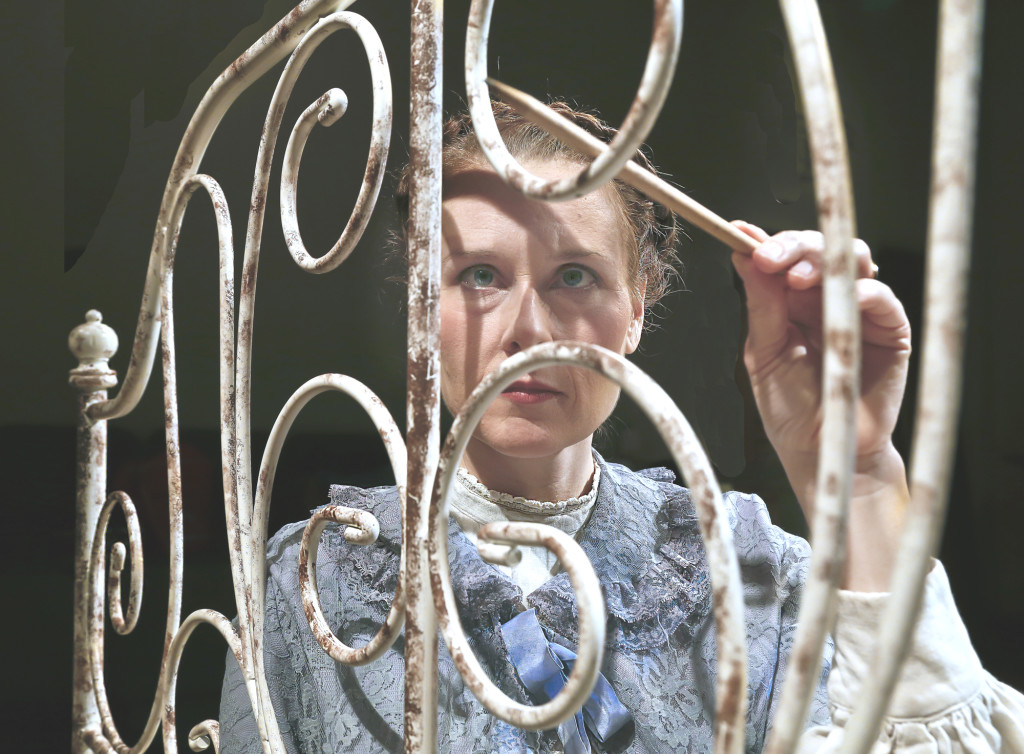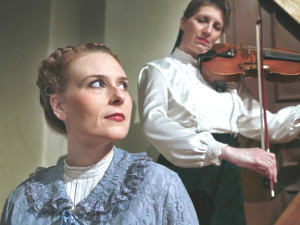
JANE (Elena Wright) endures solitary confinement in “The Yellow Wallpaper,” playing at the Berkeley City Club through June 21.
J. Norrena photos
With an intro like that, one might expect to see some of the company’s signature special effects enhancing a creepy tale, perhaps something in the style of Edgar Allan Poe. In fact, the “creeping” wallpaper is simply the focus of an isolated patient’s imaginative musings.
The subject paper, which is not represented except by verbal description, is apparently intricate, but so faded, smeared and torn away in places that Jane struggles to grasp the nature of its design.
Actors’ Equity Association member Elena Wright is Jane, a young mother who has traveled with her physician husband in late 19th-century England to a secluded country estate for a “rest cure,” some serious alone time her husband has prescribed for her to get over a bothersome “nervousness” that befell her shortly after giving birth to their son.
Ordered to remain in the solitary room for a period of three months, with little exposure to others — including her child — Jane fills the time either resting on the peeling iron-frame bed or fixating on the room’s fearfully neglected wallpaper. After a while, she imagines a kind of spirit trapped behind the obstructed patterns, struggling to find its way out.
Graves mans the light board for the performance, and there is some interest added by the simulation of night, moon and daylight as Jane describes how the changing angles and intensity of the light make the patterns in the paper appear to transform and move about the wall. The impression, though, is not that Jane is lost in a terrifying delusion, but rather that she is so bored that she deliberately imagines life where there is none, just to keep herself from going completely insane from the extended isolation.Jane wants to be a good wife and regrets burdening her husband with her nervous condition. Her spoken thoughts reveal an intense need to conform not only to her husband’s wishes but also to the prevailing cultural standards of the time. This urgent struggle between Jane’s fundamental desire to be compliant and her increasing desperation to be set free creates a dramatic tension that pulses throughout the story — but for the modern observer, a more compelling mystery lies in the extended setting, beyond the confines of the lonely room.
What is her husband up to? Does he have his wife’s best interests at heart, or is there some unknown reason for his decision to consign her to this papered dungeon? How is he occupying his time without her at this secluded property? And what about Jenny, the maid she describes? Is Jenny there in the house strictly as a friend to Jane and nursemaid to their newborn child?
Co-director Jan Zvaifler commissioned concert violinist Cybele D’Ambrosio to write and perform a musical score to punctuate the action on the stage. The music helps clue the audience in to shifts in Jane’s conscious thoughts and amplify her changing moods. The musician’s tone is exquisite and provides powerful enhancement to the drama.
“The Yellow Wallpaper” is a heady tale. The 70-minute one-act play can tend to drag on, with little to capture the eye outside of the lone figure and the bed that takes up most of the space in her room. While Wright’s execution is flawless, the story simply doesn’t lend itself easily to dramatic exposition. The production is interesting and well played, intriguing for the intellectually inclined, but it is not standard theater fare. Think of it, rather, as an intensely focused work of theatrical art.
If You Go
“The Yellow Wallpaper” continues at the Berkeley City Club, 2315 Durant Ave., Berkeley through June 21. Tickets are $15 to $28, available by calling 800-838-3006 or online at www.centralworks.org. Thursdays are pay-what-you-can at the door. For more information contact the theater at 510-558-1381.
Elizabeth Warnimont is a freelance writer specializing in the performing arts. She is also a substitute teacher for the Benicia Unified School District.







Leave a Reply